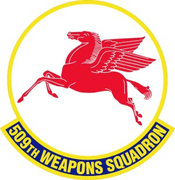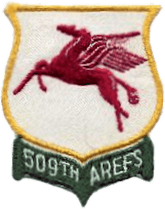509th Weapons Squadron
| 509th Weapons Squadron | |
|---|---|
|
KC-135 Stratotanker assigned to Fairchild AFB | |
| Active | 1943–1944; 1948-1965; 1966-1994; 2003 – present |
| Country |
|
| Branch |
|
| Type | Squadron |
| Role | Advanced Air Refueling Training |
| Part of | USAF Weapons School |
| Garrison/HQ | Fairchild Air Force Base, Washington |
| Engagements |
World War II (American Theater) 1991 Gulf War (Defense of Saudi Arabia; Liberation of Kuwait) |
| Decorations |
Air Force Outstanding Unit Award (with Combat "V" Device) Air Force Outstanding Unit Award (6x) Republic of Vietnam Gallantry Cross with Palm |
| Insignia | |
| 509th Weapons Squadron emblem |
 |
| 509th Air Refueling Squadron emblem (approved 15 September 1957)[1] |
 |
The 509th Weapons Squadron is a United States Air Force unit. It is assigned to the USAF Weapons School, stationed at Fairchild Air Force Base, Washington.
The 509th Weapons Squadron is a Geographically Separated Unit of the 57th Wing at Nellis Air Force Base, Nevada. The mission of the squadron is to provide Boeing KC-135 Stratotanker instructional flying.
History
World War II
The squadron was first activated as the 609th Bombardment Squadron, one of the four original squadrons of the 400th Bombardment Group, at Pyote Army Air Base, Texas, in March 1943. The group was equipped with Consolidated B-24 Liberators and served under Second Air Force as an Operational Training Unit (OTU) at several bases in the southwestern United States until the end of the year.[1][2] The OTU program involved the use of an oversized parent unit to provide cadres to "satellite groups".[3]
The unit moved to Charleston Army Air Field, South Carolina in late December, where it became part of First Air Force and changed its mission to that of a Replacement Training Unit (RTU). RTUs units were likewise oversize units, but their mission was to train aircrews prior to their deployment to combat theaters.[3] However, the Army Air Forces found that standard military units, based on relatively inflexible tables of organization, were proving less well adapted to the training mission. Accordingly, it adopted a more functional system in which each base was organized into a separate numbered unit.[4] while the groups and squadrons acting as RTUs were disbanded or inactivated.[5] This resulted in the 609th, along with other units at Charleston, being disbanded in April 1944 and being replaced by the 113th AAF Base Unit (Bombardment (Heavy)), which assumed the squadron's mission, personnel, and equipment.[1][6]
Cold War
The 509th Air Refueling Squadron was activated at Roswell Air Force Base, New Mexico and assigned to the 509th Bombardment Group.[1] The squadron was the second air refueling unit in the United States Air Force, and was activated only three weeks after the 43d Air Refueling Squadron. The squadron initially equipped with Boeing KB-29M Superfortress tankers. These aircraft carried a system of hoses, reels, winches and fuel pumps to transfer fuel to the receiver aircraft. A power-driven reel for the refueling hose was installed in the rear fuselage at the position where the lower aft turret had been located prior to its removal. The KB-29M also had a cable and associated winch (known as the contact line) that was used to assist in the setup of the connection between the two aircraft.
Although the hose refueling system proved to be feasible, in practice the system had the disadvantage in taking a long time to make the contact and engage the hoses. Once contact was made, the rate of fuel transfer was slow, and the hoses provided a lot of aerodynamic drag which limited the airspeed. Consequently, the hose system was used for only a few years before it was replaced by the Boeing-developed flying boom system installed on the KB-29L. While flying the KB-29 the squadron deployed to RAF Upper Heyford, England from June to September 1952.[1]
In 1954, the squadron converted to the Boeing KC-97 Stratotanker, deploying once again to the United Kingdom with the KC-97 for most of the first four months of 1956, this time to RAF Lakenheath. The squadron moved to Pease Air Force Base, New Hampshire in January 1958, but was not joined there by the rest of the 509th Bombardment Wing until July.[1][7] The squadron was inactivated in 1965 as the 509th phased down in preparation for inactivation.[1][note 1]
The squadron was activated again in June 1966, with Boeing KC-135 Stratotankers, when the 509th wing expanded its refueling capability by adding a second squadron of tankers to those of the 34th Air Refueling Squadron at Pease.[1] It continued to fly the KC-135 until inactivated in 1994 at Griffis AFB, New York.[1][8]
Weapons training
The squadron was reactivated in 1999 at Fairchild Air Force Base initially as the KC-135 Combat Employment School in Air Mobility Command's Air Mobility Warfare Center based at McGuire Air Force Base, New Jersey. Its first student class began in June 2000. In 2006, the Air Force consolidated all weapons squadrons under the United States Air Force Weapons School under the 57th Wing at Nellis Air Force Base, Nevada. In six months of training, weapons upgrade students receive graduate-level training in air refueling core competencies and learn to integrate and plan for joint operations. The students go to Nellis three times and receive "core" classes with the rest of the weapons school. They also go on temporary duty assignments for terminal approach tactics at Roswell, New Mexico, participate in Strategic Command integration at Offutt Air Force Base, Nebraska, certify in special operations air refueling at Hurlburt Field, Florida and exercise with Northrop Grumman B-2 Spirits at Whiteman Air Force Base, Missouri, and plan and execute a mission employment exercise from Nellis two weeks before graduation.
Lineage
609th Bombardment Squadron
- Constituted as the 609th Bombardment Squadron (Heavy) on 15 February 1943
- Activated on 1 March 1943
- Disbanded on 10 April 1944
- Reconstituted and consolidated with the 509th Air Refueling Squadron as the 509th Air Refueling Squadron, Medium on 19 September 1985[9]
509th Weapons Squadron
- Constituted the 509th Air Refueling Squadron, Medium on 30 June 1948
- Activated on 19 July 1948
- Discontinued and inactivated on 25 June 1965
- Redesignated 509th Air Refueling Squadron, Heavy and activated, on 8 August 1966 (not organized)
- Organized on 2 October 1966
- Consolidated with the 609th Bombardment Squadron on 19 September 1985
- Redesignated 509th Air Refueling Squadron on 1 September 1991
- Inactivated on 1 October 1994
- Redesignated 509th Weapons Squadron on 30 May 2003
- Activated on 1 Jun 2003[9]
Assignments
- 400th Bombardment Group, 1 March 1943 – 10 April 1944
- 509th Bombardment Group, 19 July 1948
- 509th Bombardment Wing, 16 Jun 1952
- 817th Air Division, 5 January 1958
- 509th Bombardment Wing, 8 July 1958 – 25 June 1965
- Strategic Air Command 8 August 1966 (not organized)
- 509th Bombardment Wing, 2 October 1966
- 416th Bombardment Wing, 1 July 1990
- 416th Operations Group, 1 September 1991
- 380th Operations Group, 1 June 1992 – 1 October 1994
- USAF Mobility Weapons School, 1 June 2003
- USAF Weapons School, 5 July 2006 – Present[9]
Stations
|
|
Aircraft
- Consolidated B-24 Liberator, 1943-1944
- Boeing KB-29L/M Superfortress, 1948-1954
- Boeing KC-97F/G Stratotanker, 1954-1965
- Boeing KC-135A/R/RT Stratotanker, 1966-1994[9]
See also
References
Notes
Explanatory note
- ↑ Although the decision to inactivate the wing was reversed and it instead converted from B-47s to B-52s, a new KC-135 squadron became the wing's refueling element. Ravenstein, pp. 276-277
Footnotes
- 1 2 3 4 5 6 7 8 9 Bailey, Carl E. (2007-12-19). "Factsheet 509 Weapons Squadron (ACC)". Air Force Historical Research Agency. Retrieved 29 August 2014.
- ↑ Maurer, Combat Units, p. 285
- 1 2 Craven, & Cate, Vol. VI, Men & Planes. p. xxxvi
- ↑ Goss, p. 75
- ↑ Maurer, Combat Units, p. 7
- ↑ See Mueller, p. 89
- ↑ Ravenstein, pp. 276-277
- ↑ See Mueller, p. 470
- 1 2 3 4 5 Lineage, including assignments, stations and aircraft in Bailey, AFHRA Factsheet except as noted
Bibliography
![]() This article incorporates public domain material from the Air Force Historical Research Agency website http://www.afhra.af.mil/.
This article incorporates public domain material from the Air Force Historical Research Agency website http://www.afhra.af.mil/.
- Craven, Wesley F; Cate, James L, eds. (1955). The Army Air Forces in World War II. Vol. VI, Men & Planes. Chicago, IL: University of Chicago Press. LCCN 48003657.
- Maurer, Maurer, ed. (1983) [1961]. Air Force Combat Units of World War II (PDF) (reprint ed.). Washington, DC: Office of Air Force History. ISBN 0-912799-02-1. LCCN 61060979.
- Maurer, Maurer, ed. (1982) [1969]. Combat Squadrons of the Air Force, World War II (PDF) (reprint ed.). Washington, DC: Office of Air Force History. ISBN 0-405-12194-6. LCCN 70605402. OCLC 72556.
- Mueller, Robert (1989). Air Force Bases, Vol. I, Active Air Force Bases Within the United States of America on 17 September 1982 (PDF). Washington, DC: Office of Air Force History. ISBN 0-912799-53-6.
Further reading
- Smith, Richard K. (1998). Seventy-Five Years of Inflight Refueling: Highlights, 1923-1998 (PDF). Air Force History and Museums Program. Washington, DC: Government Printing Office. Retrieved 13 August 2013.



